
<< Back | Home | Site Map
17-2-1960. Nine wagons of a Mildura bound fast goods train left the rails at 5.10 a.m. about three miles on the down side of Hattah on a steep embankment. The wagons derailed were two loaded tankers, two louvred vans, and five open wagons. One of the tankers had its bogies torn off and the other was torn open allowing distillate to flow to waste in the sand. The louvred vans and trucks carried bags of sugar, cartons of butter, tinned fruit and timber. The track was buckled and the wooden sleepers damaged, but the rails did not break.
A steam locomotive from Ouyen and a diesel locomotive from Mildura were sent to each end of the derailed train to help haul damaged wagons clear of the line. A bulldozer was used to pull wagons down the embankment to enable the track to be repaired to allow the "Fruit Flier" through. Carrier's trucks from Ouyen and Mildura were used to transfer freight to Mildura.
Passengers on both the northbound and southbound Sunlight Expresses were transported by buses beyond the damaged line.
9-4-1960. One wheel of the diesel locomotive hauling a Melbourne to Mildura goods derailed at Curyo, between Birchip and Woomelang. Another diesel locomotive was used to assist with re-railing, however a long delay ensued until it arrived at Curyo. As a result, the train arrived in Mildura 15 hours late. It was scheduled to arrive at 3 p.m. on that day but did reach Mildura until 6.16 a.m. on Sunday 10-4-1960.
19-4-1960. Six crew men escaped serious injury when the up "Fruit Flier" express goods hauled by B63 collided with a down stationary goods hauled by B81 at Redcliffs at 5.45 p.m..
The "Fruit Flier" was travelling at an estimated speed of 40 m.p.h. about 100 yards before the crash. The driver of the stationary train sounded his siren when he saw the on-coming train was going into No. 2 road instead of passing on the main line. There were five wagons on the "Fruit Flier" and B81 on the stationary train had 35 wagons. The first wagon on the "Fruit Flier" mounted the back of the locomotive in the impact. Two wagons behind B81 were thrown an estimated 15 feet into the air and a third crushed between the diesel and another truck. A wagon was tossed to one side of the track beside the two locomotives that were locked nose to nose. Diesel fuel from the locomotives caught fire soon after the crash but was quickly extinguished by the Redcliffs Fire Brigade. The brigade continued to spray water on the diesel fuel for an hour.
A special overnight passenger train that left Mildura at 9 p.m. for Melbourne was able to pass by the accident on the main line.
Railway officials began an inquiry into the crash the following day. The results of rail inquiries are not made public.
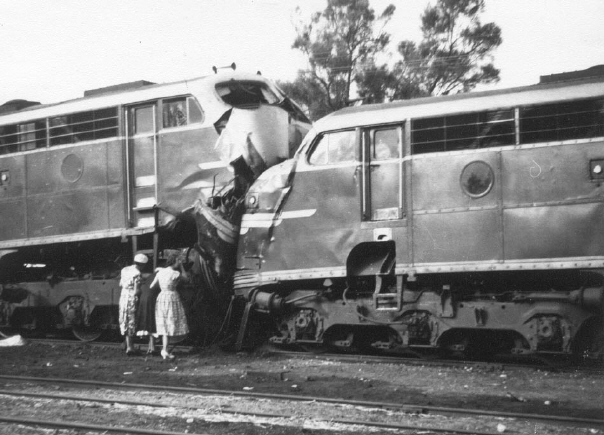
B63 (left) on the up "Fruit Flier" smashed into stationary B81 on a Mildura-bound goods at 5.45 p.m. on 19-4-1960 at Redcliffs. Photo: Barry Kerr, Geoff Pianta Collection
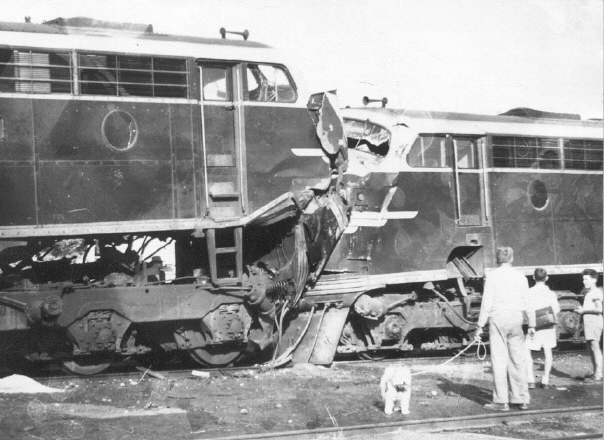
A closer view of the damaged caused to the two locomotives, B63 on the left on the up "Fruit Flier" and B81 on a goods train standing in No.2 road at Redcliffs. 19-4-1960. Photo: Barry Kerr, Geoff Pianta Collection
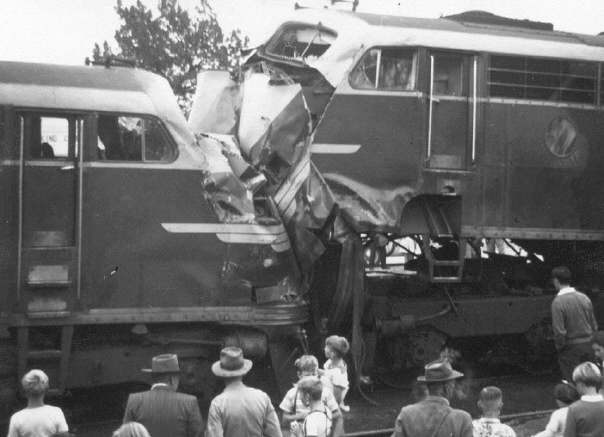
The locomotives viewed from the opposite side to the previous photo. Note how B63 has climbed up onto the nose of B81. Photo: Barry Kerr, Geoff Pianta Collection
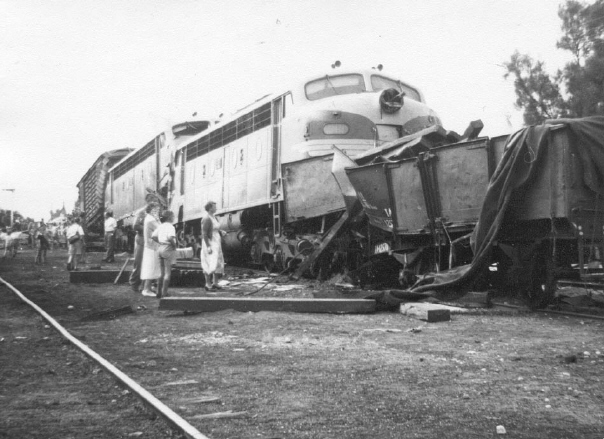
The overall scene following the collision at Redcliffs on 19-4-1960. Large crowds on on-lookers were present for the four days before workers were able to separate the locomotives and remove them to Melbourne. Both locomotives were repaired and returned to work -giving many years of sterling service. Photo: Barry Kerr, Geoff Pianta Collection
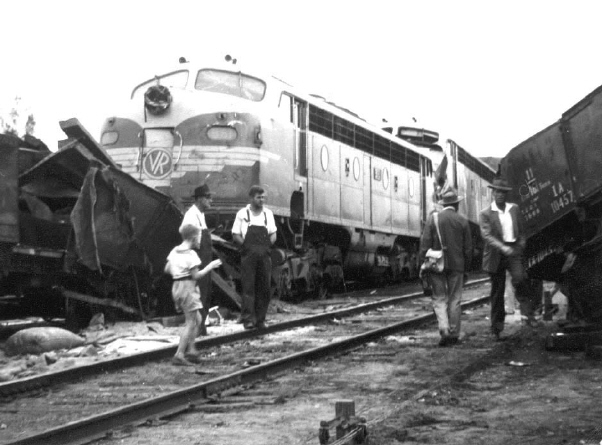
Wrecked wagons surround the crashed locomotives. The main line in the foreground was cleared to enable the restoration of rail traffic through the accident scene. Photo: Barry Kerr, Geoff Pianta Collection
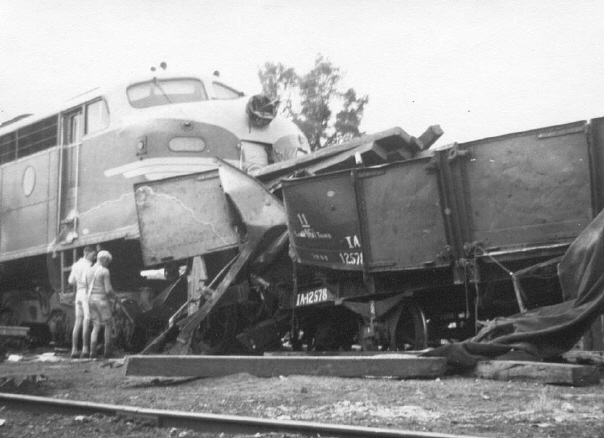
Two inquisitive young men take the opportunity to examine what the bogie and traction motors of B81 look like. The remains of a wagon between the locomotive and wagon IA-12578 indicate how the force of the impact was felt against the stationary locomotive. Photo: Barry Kerr, Geoff Pianta Collection
The crash was a major tourist attraction with hundreds of spectators mingling with television crews and press representatives. A special gang of twenty workmen and engineers from Melbourne, who arrived in a special "Accident Train" complete with sleeping accommodation, cranes and tools, worked non-stop from 7 a.m. on Thursday 21-4-1960 to 6.40 p.m. on Saturday 23-4-1960 to completely clear the wreckage.
The two 60-ton steam cranes were used to separate the diesels and lift them clear of the wreckage so that damaged sections could be cut away, the bogies removed and replacement bogies fitted for travelling.
A T Class diesel was used to haul the two locomotives back to Melbourne for repairs. Both locomotives were returned to service and continued to give the Victorian Railways many years of sterling service.
The loss of B63 and B81 created a shortage of motive power and up to five R Class steam locomotives were removed from storage to cover the six months that it would take to repair the two damaged diesels.
25-6-1960. Six wagons and a guard's van of a Mildura-bound fast goods train were derailed two miles north of Ouyen just before 4 p.m.. Briquettes from two overturned trucks were hurled over a wide area as the leading derailed truck ripped up 100 yards of sleepers and smashed through them. One truck was thrown clear and came to rest upside down. Another truck was left high on top of a third with its wheels in the air. The other wagons derailed were an empty wagon, one empty louvre van loaded with superphosphate and the guard's van. The guard escaped injury. Railway gangers worked in extremely cold conditions using a bulldozer to clear the derailed trucks down a slight embankment. The men worked without a break until 4 a.m. the following morning to get the track open again to allow trains to pass through. The derailment was on a section of the line that had recently been relaid and strengthened with bluestone ballast. The Up 8.55 p.m. passenger train from Mildura arrived at Spencer Street 7 hours late and the up "Fruit Flier" was delayed 12 hours.
22-7-1960. Eight vehicles of an up goods from Pinnaroo hauled by N408 were derailed near Tutye.
24-3-1961. A goods train for Mildura derailed about two miles on the up side of Carwarp. A shattered axle was believed to be responsible for the derailment in which five loaded wagons were derailed. A steam crane was sent from Melbourne to assist railway workers recover the damaged wagons, one of which was about 80 feet from the tracks. The damaged wagons were lifted onto flat wagons and taken to Carwarp before being forwarded to Melbourne.
The derailment caused the "Fruit Flier" express goods to be terminated en route and return to Mildura. Seven buses were required to transfer passengers from stations along the line to Birchip. There they were transferred to the train from Melbourne which then returned with the passengers off the buses. The buses then took the passengers off the Melbourne train to stations between Birchip and Mildura, arriving in Mildura at 8 a.m.. A Mildura carrier took goods from the passenger van to and from Birchip.
There was criticism that the fresh produce on the "Fruit Flier" was held over from Friday night and did not leave Mildura until Sunday night.
19-6-1961. Six wheat wagons were derailed at Boinka station. Workmen extended the loop line at the station around the damaged wagons to ensure that traffic on the line could continue until the wagons were recovered.
24-7-1961. A bogie wagon was derailed at the down end of Mildura station yard. The van split the points during shunting and ended up blocking two sets of tracks for several hours.
28-11-1961. Wagon 4BP was derailed when shunted over the buffers of the SEC siding at Redcliffs. As the main line was not affected, re-railing operations did not commence until midday the following day. The SEC Siding is normally used for the unloading of briquettes or oil fuel for the SEC power station at Redcliffs, but as No.2 and No.3 tracks were required for Wirth's Circus special train, all spare wagons were shunted onto this siding.
21-2-1962. A steam locomotive was partially derailed when it ran through a set of points found to be jammed open with firebricks and debris. Investigations revealed that all sets of points at the Mildura locomotive depot near the intersection of Seventh Street and Cherry Avenue had been similarly tampered with.
20-4-1962. A wheel fault on a wagon loaded with coal for steam locomotives at Mildura, was believed responsible for the derailment of fourteen wagons a mile and a half south of Carwarp at 8.30 p.m. Good Friday evening. The derailed wagons were in the centre of a train of 48 wagons. Three petrol tankers were derailed but did not overturn or lose any fuel. Nine of the fourteen wagons were extensively damaged.
A bulldozer was taken to the scene to assist the following morning to build an embankment so that railway workers could build a 250 yards loop line around the damaged track. Gangers from Ouyen, Redcliffs and Nowingi were called in from their Easter holidays. A railway steam crane was sent from Melbourne and reached the scene early Easter Monday.
Passenger services were interrupted by the derailment. The Mildura to Melbourne passenger train departed at 9 p.m. but was stopped at Redcliffs where all passengers were transferred into three buses and taken to Birchip. The Melbourne to Mildura train was stopped at Birchip at 3.30 a.m. and returned to Melbourne with the passengers from the buses. The same buses were then used to take passengers off the train from Melbourne to stations between Birchip and Mildura. Birchip was selected as the change-over point as it had refreshment facilities.
The line was ready for traffic in time for the normal Sunday night service from Mildura to pass through on the temporary by-pass track.
3-5-1962. Diesel-electric locomotive B64 was derailed at Mildura about an hour before it was to depart with the Up "Fruit Flier". The "Fruit Flier" departed Mildura behind the Mildura pilot engine K190 which changed over with the diesel off the Down "Mildura Sunlight" at Irymple, and returned to Mildura hauling the "Mildura Sunlight". As the latter diesel was required to run No. 130 fast goods to Melbourne, this train was held pending completion of re-railing B64, but when this was not completed by 11 p.m., K190 was again utilised and ran this train as far as Ouyen where it changed over with B82 off the 8 p.m. Donald to Mildura fast goods.
23-5-1962. A steam locomotive was derailed when it passed over a set of points that had been tampered with by vandals and jammed open with pieces of limestone. The driver and fireman on the locomotive jumped clear as the locomotive boiler unit and tender jack-knifed into an "L" shape. The footplate between the engine unit and tender was damaged and if the crew had not jumped clear, it was possible they would have sustained serious injuries to their legs. The locomotive was travelling from Mildura railway station to the locomotive sheds. The tampered points were near the Seventh Street and Cherry Avenue intersection - the same place where a similar incident occurred on 21-2-1962.
24-1-1963. Six wagons on a goods train bound for Mildura were derailed between Hattah and Nowingi. The derailment occurred about 3 a.m.. Two 9,000 gallon petrol tankers were involved, with one tanker ruptured in two places. One wagon filled with stone screenings was hurled 30 feet off the line. Other wagons included an empty guards van, a wagon loaded with flour and another carrying superphosphate.
The diesel locomotive hauling the train continued to Mildura with the front portion of the train. The wagons on the rear of the train were hauled back to Ouyen. An empty 9,000 gallon rail tanker was brought from Mildura and propelled to the accident scene at 5 m.p.h. to avoid the possibility of any sparks. A steam crane was sent from Melbourne to assist in recovering the damaged wagons.
A gang of about 30 men, assisted by a Shire of Mildura bulldozer, worked in the hot sun to build a by-pass track around the 80 yards of damaged track. They completed the track late in the afternoon in time for the "Fruit Flier" goods train from Mildura to safely pass through. The Mildura Sunlight from Melbourne also passed through, arriving in Mildura a few minutes later than its scheduled time.
The Mildura Sunlight service from Mildura to Melbourne was cancelled and 100 passengers were taken from Mildura to Birchip by bus.
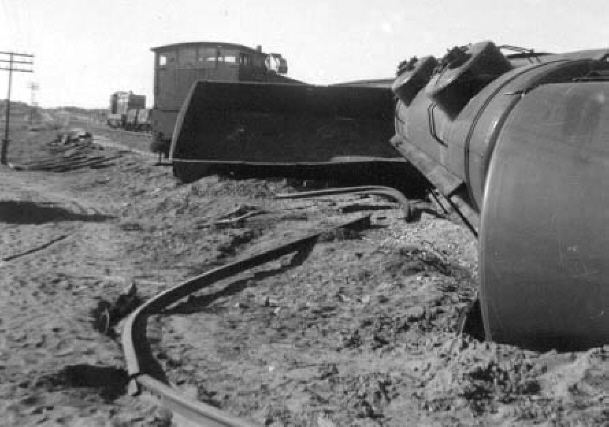
Wrecked wagons and guards van following the derailment of a Mildura-bound goods train four miles north of Hattah on 24-1-1963. Photo: Barry Kerr, Geoff Pianta Collection
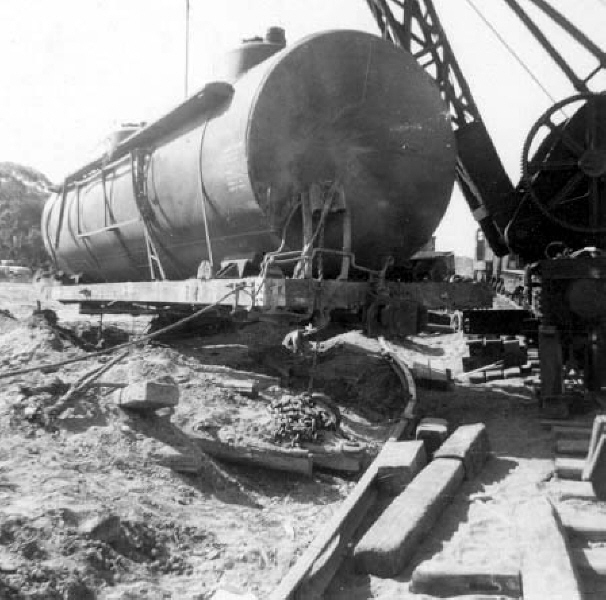
Steam crane lifting 9,000 gallon fuel tanker during wagon recovery operations following derailment north of Hattah on 24-1-1963. Photo: Barry Kerr, Geoff Pianta Collection
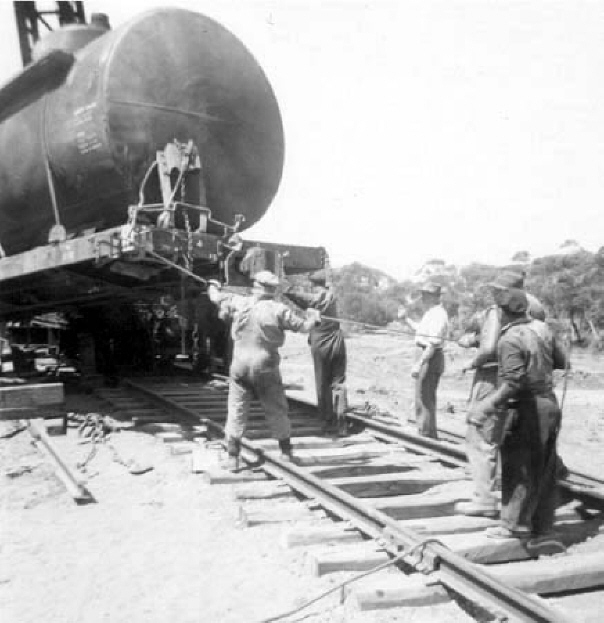
Workmen assist the steam crane operator to manoeuvre a petrol tanker during recovery operations following a derailment between Hattah and Nowingi on 24-1-1963. Photo: Barry Kerr, Geoff Pianta Collection
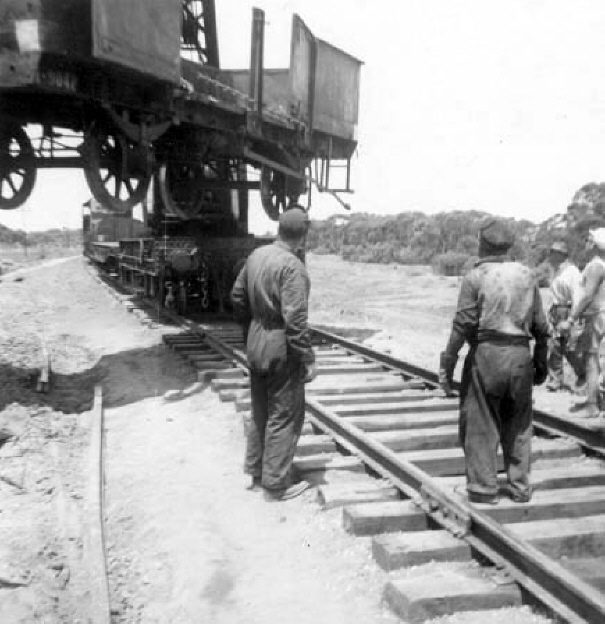
Workmen watch on as a steam crane brought from Melbourne, lifts a damaged I class wagon back onto the rails following a derailment at approx. 314 miles between Hattah and Nowingi on 24-1-1963. Photo: Barry Kerr, Geoff Pianta Collection
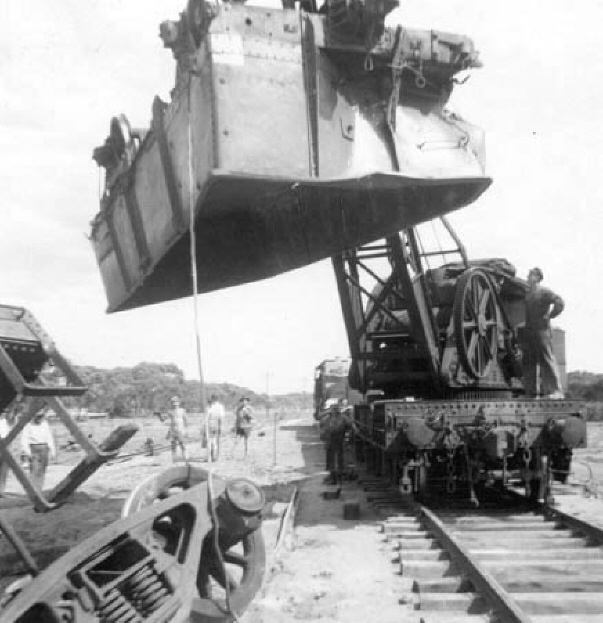
A steam crane stands on the by-pass track constructed by gangers to lift damaged wagons back onto the track or onto flat wagons for transport back to workshops in Melbourne for repairs or scrapping. The men in the background are standing on the original alignment of the track before the derailment. Photo: Barry Kerr, Geoff Pianta Collection
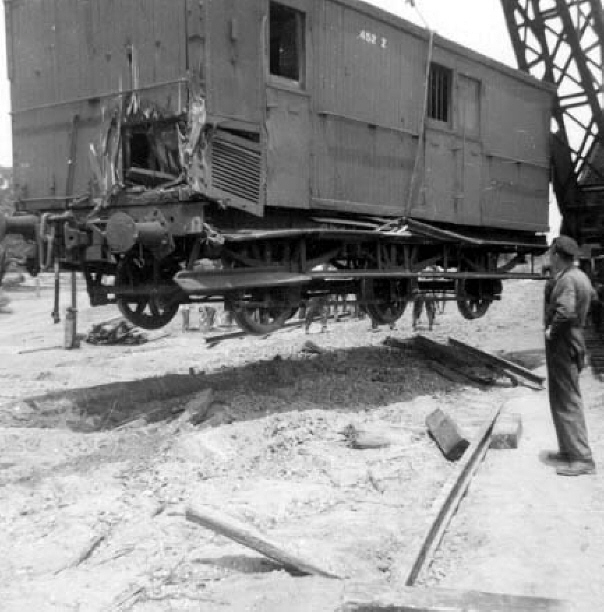
Brake van 452Z is lifted into the air during recovery operations following the derailment of the van and five other wagons four miles north of Hattah on 24-1-1963. The van was in the centre of the train and was unoccupied. Photo: Barry Kerr, Geoff Pianta Collection
Following removal of the damaged rolling stock, railway gangers were able to start relaying the 80 yards of damaged main line. Work was completed by 30-1-1963.
6-2-1963. The up and down Mildura Sunlight trains were delayed about an hour at Curyo following the derailment of six wagons off a goods train. The damaged track was repaired by 6 p.m. that night.
8-12-1964. B64 on a Mildura to Melbourne goods train failed about 9 a.m. near Carwarp. A replacement diesel was sent from Mildura and the failed engine was returned to Mildura by steam locomotive R730 sent from Ouyen.
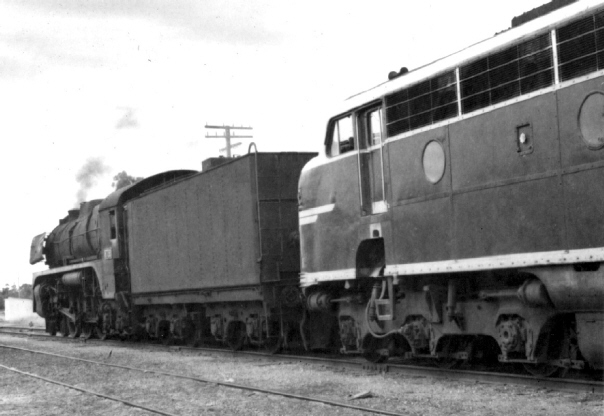
R730 with Driver G.Cullen hauls disabled B64 at Redcliffs on 8-12-1964. B64 had failed that morning near Carwarp and R730 was sent from Ouyen to haul it back to Mildura for repairs. Photo: Photographer unknown - Bruce McLean Collection
9-2-1965. An oil tanker derailed and damaged about 200 yards of track about 7.30 a.m., near Nowingi. The tanker was the second last wagon on a train of 29 vehicles. Railway gangs from Nowingi and Ouyen and the Mildura loco foreman (Mr. R. Smith) jacked the tanker back on to the track. The goods train was delayed about three hours and caused the cancellation of the 8.15 a.m. Mildura to Melbourne "Mildura Sunlight" passenger service. Buses were used to convey passengers to Birchip where they were able to resume their journey by train to Melbourne.
3-4-1965. A wagon on a goods train damaged about three miles of railway sleepers when it became derailed about 8.30 p.m. at the level crossing near the site of Yatpool station.
20-9-1965. Nineteen Marching Girls and their chaperons became ill on the overnight train from Melbourne to Mildura. A conductor in the train's relieving crew noticed a strange odour in the compartments of 19 BE air-conditioned second class carriage when he joined the train at Cope Cope. As soon as he learned some of the passengers were ill he arranged to have them transferred to an AZ first class carriage. The BE carriage was removed from the train at Woomelang and sent back to Melbourne to ascertain the cause of the problem. Six of the victims were transferred to hospitals at Creswick, Hopetoun and Mildura.
The Railway Commissioners initially commented that the only gas used in the carriage air-conditioning system was freon which was non-toxic, odourless, completely harmless and invisible.
Following their investigations, the Deputy Chairman of Commissioners (Mr. G. Brown) announced that the carriage had been cleared of any fault and had been returned to service without any further incident. The problem, it appeared, was traced back to the affected people having consumed something in common. The symptoms of the railway conductor treated on arrival at Mildura were different to the affected passengers.
8-2-1966. A first class wooden passenger car was shunted through the end of the Mildura carriage shed, finishing up about 20 feet beyond the end of the siding.
20-4-1966. A B Class diesel locomotive and two of the five wagons it was hauling was derailed at the Pinnaroo line junction at Ouyen. About 50 yards of track was torn up. A loop line was constructed around the derailment and was open for traffic at 8.45 p.m. the following day. The derailment caused a bank up of trains at Ouyen with the Mildura-bound "Fruit Flier" and another goods train on the up side of the blockage. The Melbourne-bound passenger train from Mildura was held at Ouyen station with passengers taken to Birchip by bus.
10-5-1966. The diesel-electric locomotive on the Mildura Sunlight from Mildura to Melbourne failed on the up side of Ouyen. A steam locomotive was attached to the train and taken to a station further on (details not known, but possibly Speed) where another diesel was attached to complete the journey.
7-7-1966. Diesel-locomotive B83 became totally disabled at Nowingi on the 7 p.m. Up Mildura goods. Steam locomotive J512 was sent from Ouyen to haul the train and the defective locomotive back to Ouyen. Diesel-locomotive T365, which had worked to Ouyen attached to the 6.30 p.m. Down goods from Donald, took over the train, also hauling B63 to Dynon for repairs.
9-8-1966. Two J Class steam locomotives collided at the down end of the Mildura station yard at 12.10 p.m.. J507 had arrived at Mildura from Ouyen and was proceeding towards the locomotive sheds on No.2 road. At the same time, J516 was running tender first from the "river road" - the track nearest the Murray River in the yards - and collided with J507. The engine driver and his fireman and two shunters were on the footplate of J516 and jumped clear just before the locomotives collided. They possibly avoided a more tragic outcome by jumping clear as the impact of the collision caused the tender on J516 to break away, leaving them without any support. The crew on J507, from Ouyen, were unhurt. The driver of J516 was unhurt, his fireman received a cut ear, a shunter broke a bone in his arm and another shunter suffered a broken leg.
The leading wheels on J517 were derailed through the force of the impact. The tender of J516 rolled about 180 yards, almost reaching the Chaffey Avenue level crossing. The Mildura Loco Foreman, Mr. R. Smith, who lived near the scene of the collision and was having lunch at the time, ran to the yards and climbed onto the runaway tender just as it started to roll backwards. Mr. Smith applied a handbrake and avoided the tender rolling back into the two damaged locomotives. The front right hand buffers on both engines were torn off by the impact, with one from J516 being hurled through the air across two tracks and crashed into a corrugated iron wall of Thomas National Transport, 60 feet away.
Track gangs worked through the rest of the day re-railing the locomotives.
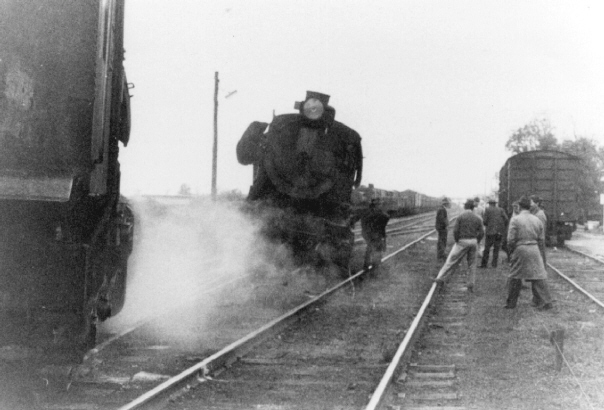
The scene following the collision between J507 and J516 at Mildura. J507 is shown derailed on No.2 road. The footplate that normally covers the connection between the engine and tender of J516 can be seen to the middle left of the picture. 9-8-1966. Photo: Bruce McLean Collection
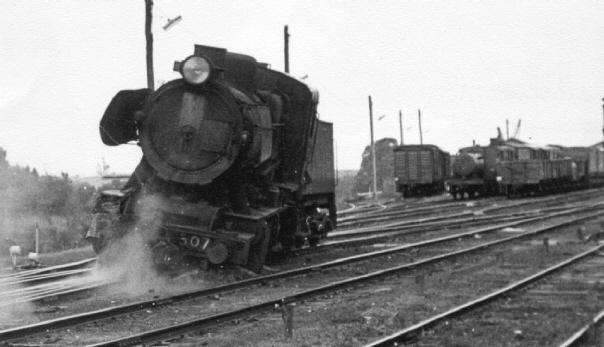
J507 had just arrived from Ouyen and was heading down No.2 road to the steam locomotive depot. It collided with J516 on the points immediately to the front of the engine. Mildura. 9-8-1966. Photo: Bruce Mclean Collection
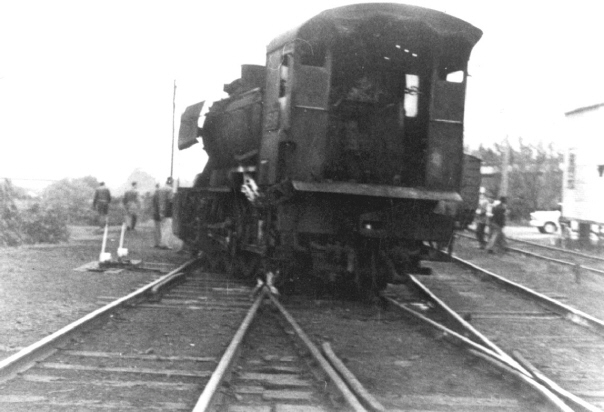
J516 without its tender following its collision with J507 on 9-8-1966. The crew on the locomotive jumped in time to avoid possible death. J516 was also derailed in the accident. Photo: Bruce McLean Collection
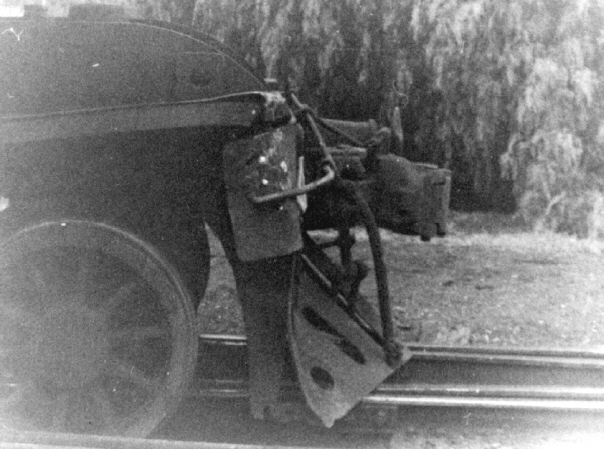
Close up view of the buffer beam on J516 with the buffer missing after the collision with J517 on 9-8-1966. The buffer was thrown through the air and crashed through the wall of a nearby building, fortunately without hitting anyone. Photo: Bruce McLean Collection
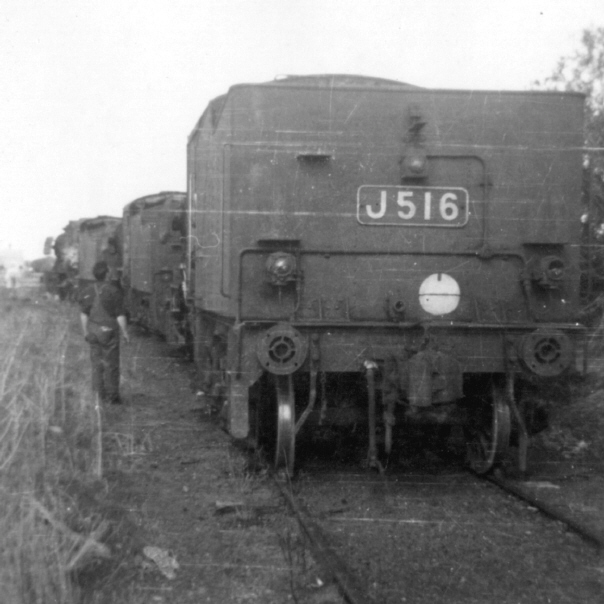
J516 and J507 are being prepared for haulage behind another steam locomotive at Ouyen locomotive depot. They were being worked back to Melbourne for repairs following their collision in Mildura on 9-8-1966. Photo: Bruce McLean Collection
12-8-1966. During shunting operations with the 6 p.m. Up goods from Mildura at Nowingi, five wagons were derailed about 8 p.m., blocking the main line for about four hours. The derailment caused little damage but resulted in passengers having to be transferred by bus to and from Birchip.
The 9 p.m. overnight passenger service from Mildura to Melbourne was cancelled and passengers and luggage were taken by four buses and two trucks to Birchip where they were transferred to the 8.10 p.m. train from Melbourne which was terminated there and returned to Melbourne. Passengers off the train from Melbourne transferred to the buses from Mildura, arriving at the northern terminus at 7 a.m..
12-12-1966. Christmas mail deliveries were delayed following the late arrival of the overnight train from Melbourne. The delay was caused by the failure of the diesel locomotive at Birchip, however it was able to continue to Ouyen where it was replaced by another locomotive, eventually arriving in Mildura at 8.08 a.m..
8-6-1967. Two wagons on a Mildura-bound goods train were derailed at Watchem at 1.40 a.m.. Rail traffic was delayed for ten hours until the line was cleared. The Melbourne to Mildura passenger train was stopped at Watchem and the Mildura to Melbourne train stopped at Donald. Passengers were transferred between the trains by buses and the trains returned to their originating stations.
17-7-1967. When diesel-electric loco T333 failed near Hattah whilst running the 6 p.m. Up Mildura goods, Ouyen yard pilot, steam loco J504, was sent to rescue the train. T333 was able to run light to Ouyen under its own power and another T Class loco was added to the Down "Fruit Flier" at Ballarat to haul the 6 p.m. Up between Ouyen and Melbourne.
28-7-1967. The Down Mildura passenger train was delayed when diesel-electric locomotive B71 became a total failure near Rockbank. Loco B79 on the Down Mildura goods was detached from that train at Sunshine and pushed the disabled train to Rockbank and then ran the train to Mildura, arriving 2 hours 20 minutes late.
26-9-1967. Twelve wagons on a goods train hauled by B63 and T363, travelling to Mildura, were derailed near Ouyen about 6 a.m.. Two petrol tankers, two wagons carrying flour, two wagons loaded with railway sleepers and four empty wagons were damaged, with one of the two petrol tankers being split open and leaking fuel. It was not possible to build a temporary connection around the wreckage due to the terrain. Railway crews used bulldozers to clear the damaged wagons and the track was restored early the following day.
The Melbourne to Mildura overnight train was held at Ouyen with passengers brought forward by buses to stations north of Ouyen. Passengers on the 9.20 p.m. Mildura to Melbourne train were transferred to Ouyen by buses and were placed on the train that had arrived earlier in the day from Melbourne. The "Fruit Flier" and overnight train from Melbourne on 27-9-1967 were able to clear the section and arrive in Mildura on schedule.
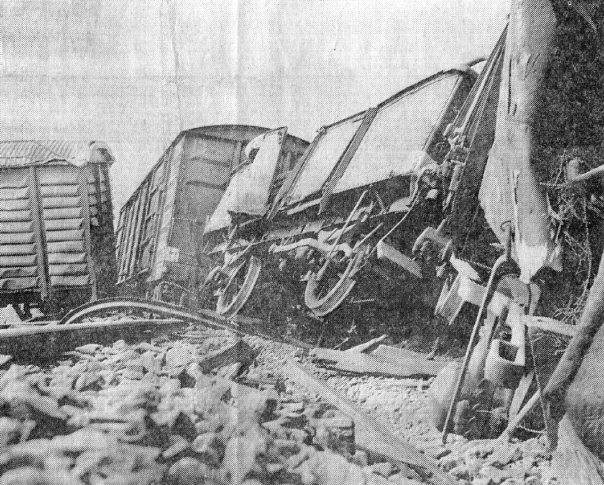
Press clipping from "Sunraysia Daily" 27-9-1967 showing damaged track and wagons from derailment at Ouyen on 26-9-1967. Source: Bruce McLean Collection
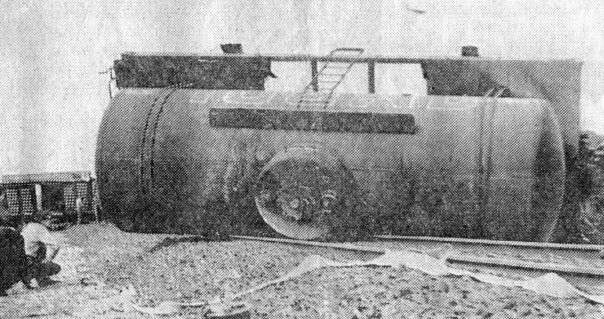
Press clipping from "Sunraysia Daily" 27-9-1967 showing upturned fuel wagon from derailment at Ouyen on 26-9-1967. Source: Bruce McLean Collection
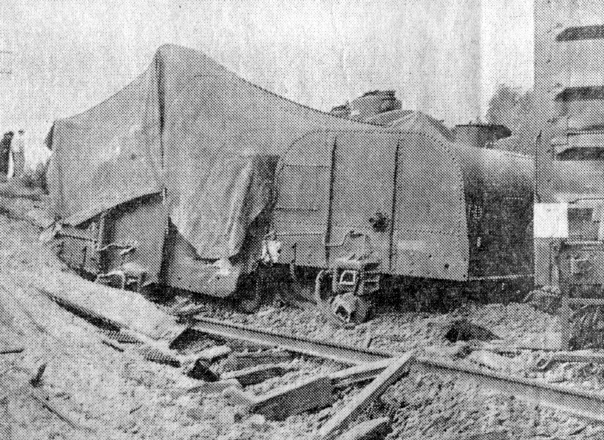
Press clipping from "Sunraysia Daily" 27-9-1967 showing damaged track and wagons from derailment at Ouyen on 26-9-1967. Source: Bruce McLean Collection
14-2-1968. Two people were injured when their station sedan crashed into a T Class locomotive hauling a 9,000 gallon fuel tanker at the Eighth Street, Mildura, level crossing at 8.45 a.m.. The train was heading from Mildura station yard to the fuel depots between Ninth and Tenth Streets and the car was travelling eastwards from Ontario Avenue. The station sedan was pushed 30 yards along the track following the impact.
7-3-1968. Diesel locomotive T330 was derailed when it split the points at 8.15 p.m., just over an hour before it was due to haul the 9.20 p.m. Mildura to Melbourne overnight passenger train. Workmen took nearly two hours to re-rail the locomotive. The cause of the accident was attributed to children wedging a piece of coal in the points, causing them to be only partially closed. A replacement engine was detached from a goods train at Hattah and arrived at Mildura at 10.20 p.m..
4-7-1968. Seventeen wagons on a Melbourne bound goods train hauled by T331 were derailed at the site of Trinita station at 10.00 p.m.. The goods train had departed from Mildura at 6.30 p.m.. Some of the wagons tipped onto their sides whilst others remained upright and all sustained damage. There was little damage to goods, including dried fruit which was transferred to road trucks and taken to Ouyen for transfer to wagons on another train. Railway gangs from Mildura, Ouyen, Meringur and Tempy, assisted by bulldozers, replaced the damaged section of track in time to allow the following night's (Friday) passenger train through.
The overnight train from Mildura was halted at Hattah and passengers were transferred to buses and taken to Ouyen. At Ouyen they transferred into the Pinnaroo diesel rail car which took them to Donald where the train from Melbourne to Mildura was waiting. This train was reversed and returned to Melbourne. The Pinnaroo rail car then brought the passengers from Donald to Ouyen, where they were transferred to buses, before joining the waiting train at Hattah which departed at 8.40 a.m. and returned to Mildura about 10.00 a.m..
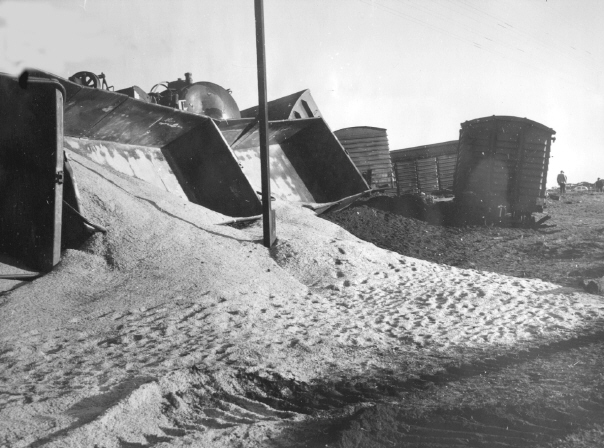
Damaged wagons at the site of Trinita station following a derailment on 4-7-1968. Seventeen wagons on the up goods from Mildura to Melbourne were derailed including wagons of gypsum picked up at Nowingi. Photo: Sunraysia Daily
25-7-1968. A loaded diesel fuel tank wagon on the 9 a.m. Down goods hauled by T396, was derailed near Ouyen damaging about 600 yards of track. It was the only one of 29 wagons on the train. The Mildura to Melbourne overnight train was delayed and arrived in Melbourne about four hours late. The overnight train from Melbourne to Mildura arrived in Mildura about 20 minutes late and the Melbourne to Mildura "Fruit Flier" was 1 hour and 20 minutes late arriving at Mildura.
14-10-1968. Walker Rail Motor RM9 suffered some minor fire damage to electrical equipment and cab fittings at Cowangie. The Ouyen Y Class pilot ran light to Cowangie and hauled the rail motor back to Ouyen using chains to make the coupling. RM9 was rendered serviceable by the Mildura loco foreman and was available to run the service by 16-10-1968.
11-3-1969. A car collided with T357 and a guards van at the Cowra Avenue level crossing between Irymple and Mildura at 5.35 p.m.. The locomotive and van had returned from Meringur with a grain train and had left the wagons at Redcliffs. The 19 year old female driver of the car, who lived only 300 yards from the level crossing, was killed. T357 sustained only minor damage.
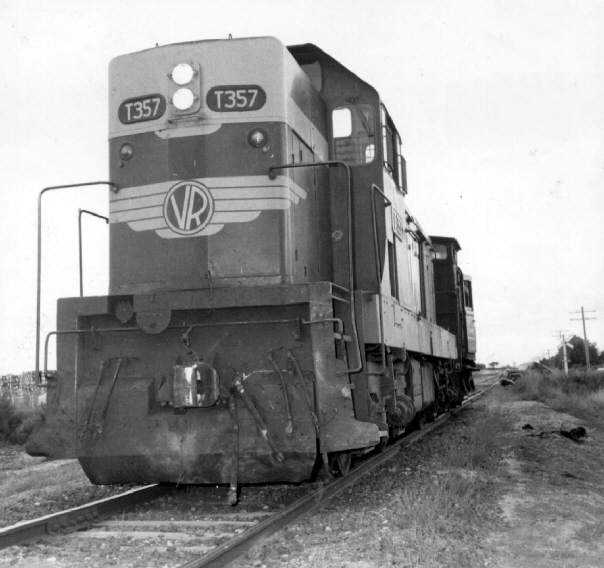
T357 shortly after being hit by a car at the Cowra Avenue level crossing between Irymple and Mildura on 11-3-1969. Only minor damage was sustained, however the driver of the car in the background was killed. Photo: Sunraysia Daily
20-3-1969. A tank wagon on a Mildura to Melbourne goods train was derailed between Nowingi and Hattah about 9.45 p.m., delaying the train about 4½ hours. The empty tanker, used for diesel locomotive fuel, was slightly damaged. Gangers from Ouyen rerailed the wagon and it was shunted into a siding at Nowingi for repairs before being returned to Mildura. There was no damage to the track.
22-4-1969. A spectacular collision between the overnight passenger train to Mildura and a fully laden fuel tanker at the Irymple Avenue level crossing at the up end of Irymple station yard resulted in the death of the train driver, and injuries to the train fireman, truck driver and a lady passenger. The locomotive T398, Motorail wagon AX7 and Sleeper No.1 were badly damaged.
The petrol tanker, loaded with 6,000 gallons of super grade petrol, collided with the passenger train about 8.20 a.m.. It was owned by Williams Transport of Euston, New South Wales, had just arrived from Adelaide, and was heading to a nearby petrol depot on the opposite side of the crossing.
As a consequence of the impact, T398 was knocked over onto its side, trapping the driver (from Donald) under the cabin side, and burning him to death. The fireman, also from Donald, was either catapulted from the engine or hurled into the air by the explosion that followed and was found fifty yards away from the wreckage with his clothes ablaze. He was admitted to hospital with burns. T398 was completely burned.
Eye witnesses claimed the petrol exploded in a yellow ball of flame that shot 150 feet into the air, setting fire to a railway departmental residence occupied by the Assistant Stationmaster and his family. The house was destroyed. A south-westerly breeze prevented the fire spreading to the petrol depot.
Motorail wagon AX 7, immediately behind the locomotive, was in the centre of the explosion and fire. Two motor vehicles on the wagon were destroyed.
The leading end Sleeping Car No.1 was engulfed by petrol and damaged by fire. It was generally accepted that if the Motorail wagon was not positioned between the locomotive and the sleeping car, there could have been more tragic consequences for passengers. A Mildura lady was the only passenger admitted to hospital for shock, but several other passengers were upset by their near escape.
Railway gangs worked throughout the day and night and into the following day to remove the overturned locomotive, damaged rolling stock and replace the damaged track. A bulldozer was used to relocate the power bogies of T398 onto the track and the bogies off AX7. The railway wrecking train from Melbourne arrived the following night (23-4-1969) and was used to lift the locomotive and wagon.
(Note: The author of this history lived close to the accident at the time and was the first person to capture the accident on film. The dramatic photos of the fire were used on the front page of the Melbourne "Herald" and in the "Sunraysia Daily" coverage.)
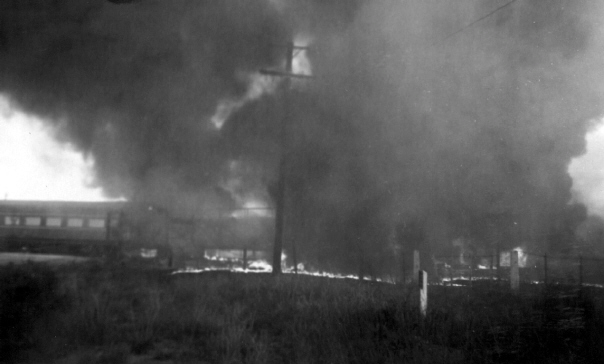
The scene following the collision and explosion between T398 and the Mildura-bound passenger train and a fully-laden petrol tanker at Irymple Avenue, Irymple on 22-4-1969. The author was the first person with a camera and this was the scene as he arrived at the accident about five minutes after the impact. Photo: Bruce McLean
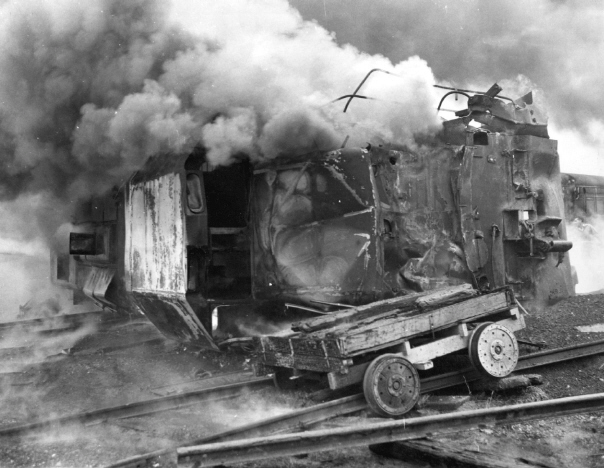
The fire that engulfed T398 is still burning and the position of the locomotive across the tracks indicates the force of the impact when hit by the petrol tanker. At the time this photo was taken, it was not realised that the driver from Donald was trapped under his locomotive and burned to death. Photo: Bruce McLean
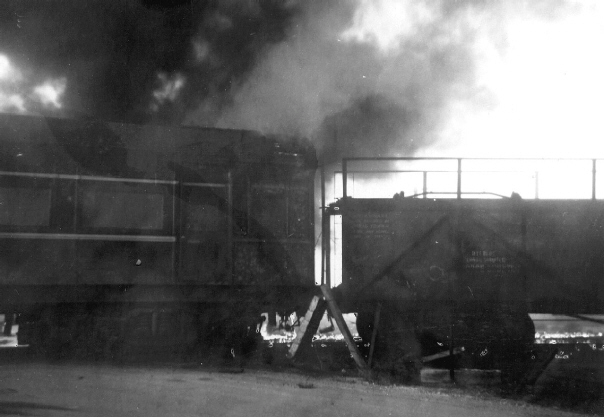
Sleeper No. 1 is burning, with smoke emitting through the air-conditioning ventilation system on the end of the carriage. Motorail wagon AX7 with two cars was engulfed by fuel and flame, destroying two motor vehicles on board. Photo: Bruce McLean
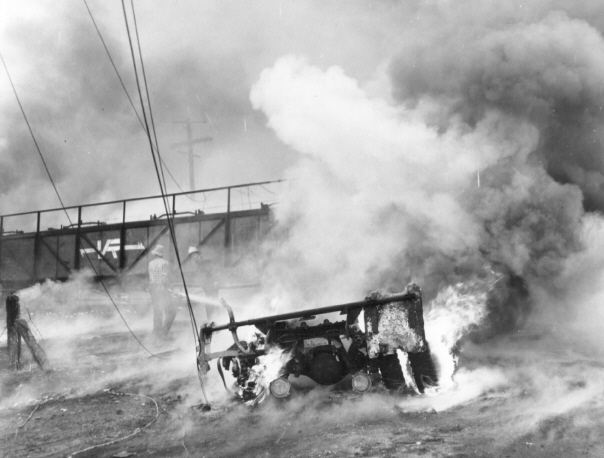
Firemen keep the burning remains of the petrol tank prime-mover under control. The prime-mover and tank trailer were completely destroyed, there being little evidence of the tank at all. Photo: Bruce McLean
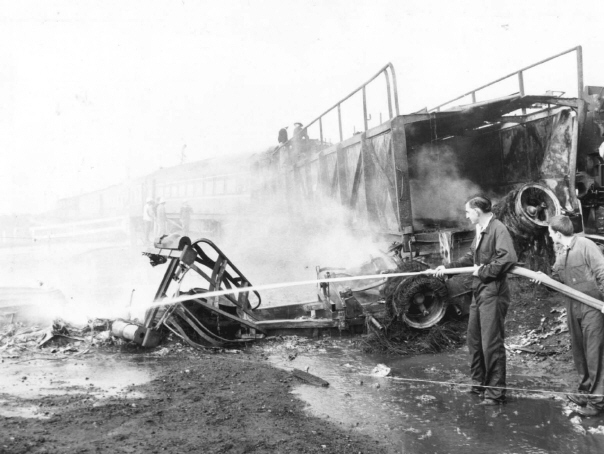
Volunteer firemen hose the remains of the tanker trailer. This view provides a view of the point of impact and subsequent explosion and the role of the Motorail wagon in preventing loss of life in the sleeping car. Photo: Bruce McLean
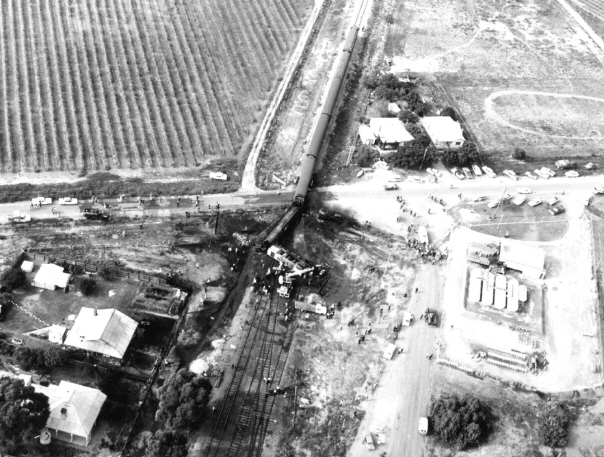
Aerial view of the Irymple crash scene. T398 can be seen on its side across the tracks with the AX Motorail wagon and Sleeper No. 1 immediately behind. The train passenger carriages were not moved from the scene for some hours and passengers were taken to Mildura by bus following the collision. The fuel depot destination for the loaded tanker can be seen to the right and the railway departmental residence that was burned as a result of the explosion that followed the collision is the house nearest to the accident scene. The black scorch marks made by the flaming fuel can be seen all around the site. Photo: Sunraysia Daily
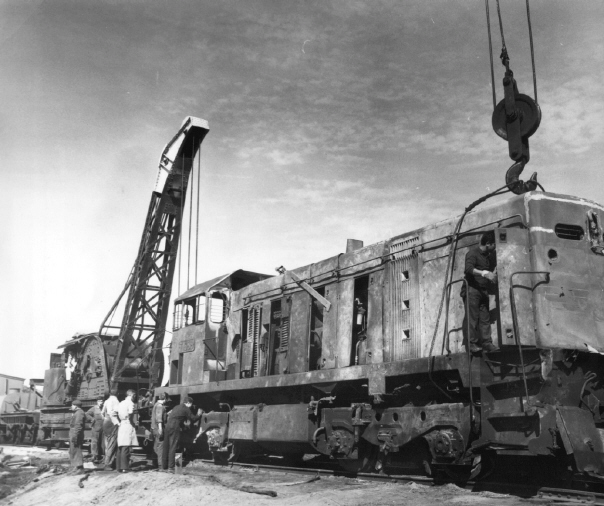
The railway wrecking crew has arrived from Melbourne with their cranes and have lifted T398 onto its bogies on the track. In the process T398 ended up facing the reverse direction. The locomotive was then hauled into Mildura for further preparation prior to being returned to Melbourne to be assessed for re-building. Photo: Bruce McLean
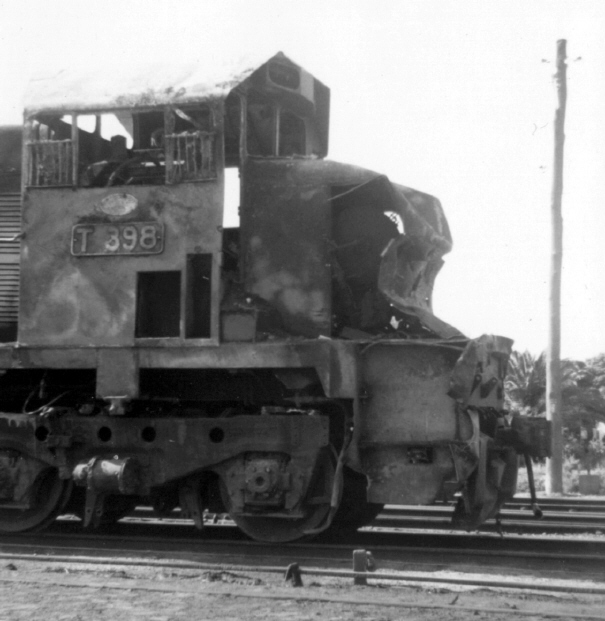
The front of T398 that collided with a fully-laden fuel tanker at Irymple on 22-4-1969, trapping and burning the train driver to death. T398 was moved to Mildura to be prepared for hauling to Melbourne. 24-4-1969. Photo: Bruce McLean
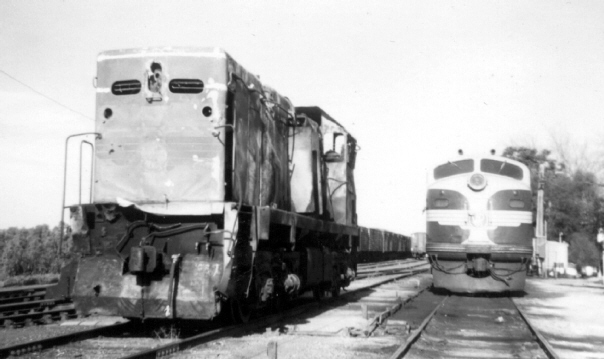
T398 is a sad sight at it stands beside B74 at Mildura on 24-4-1969. Photo: Bruce McLean
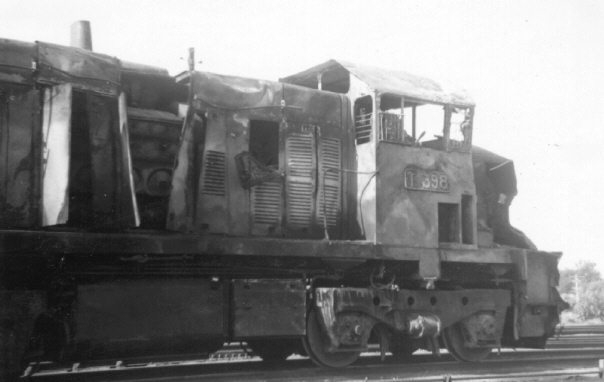
Another view of damaged and burnt-out T398 at Mildura, prior to being transferred to Melbourne. T398 was subsequently re-built and returned to service. Photo: Bruce McLean
On 3-11-1969 Mildura Coroner's Court began an inquest into the cause, manner and death of the train driver Mr. J.R. Foletti of Donald following the collision between the Melbourne to Mildura train and a petrol tanker truck on 22-4-1969.
The District Coroner (Mr. J.W. Hayes) returned a finding of death by misadventure. The Coroner was satisfied that the petrol tanker driver had been negligent to a high degree by driving his tanker over the level crossing at Irymple Avenue, Irymple, without at first stopping the vehicle as required under the Inflammable Liquids Regulations 1968. The regulations said that any vehicle carrying more than 540 gallons of inflammable fuel had to stop at any railway crossing not equipped with boom gates, wig-wag signals or flashing lights.
The petrol tanker driver was fined $200.00 with $85.00 costs by Mildura Court on 10-2-1970
for failing to stop at a railway crossing.
On 24-6-1970, the Victorian Railways Commissioners took out a Supreme Court Writ against
Williams Transport Pty. Ltd. of Euston, N.S.W. and Jeffrey Gillett Collins, of Morphett Vale,
South Australia. The Commissioners sought damages of $120,427.89 from the defendants for repairs and placements made necessary by the collision. These included repairs to the locomotive, a wagon and a sleeping car, repairs to a house owned by the Victorian Railways and repairs to the track, fencing, signals, signs, linen, cutlery and crockery destroyed in the sleeping car.
* Locomotive T398 was returned to service and was withdrawn 6/1989.
* Sleeper No.1 was repaired and returned to service. It is preserved and maintained by Steamrail Victoria since 30-8-1990 for special train working.
* AX7 was repaired and returned to service. It was scrapped in 1993.
23-6-1969. Vandals tampered with five sheep wagons standing on the Mildura wharf siding, resulting in a LF bogie sheep wagon being detached and rolling over the baulk at the end of the siding. Workmen spent the next morning rerailing the wagon.
9-7-1969. Eight GJX bulk wheat wagons were derailed at Sutherland, near St. Arnaud . The line was cleared the following morning.
29-10-1969. A cattle truck derailed at 4 a.m. at Lascelles, blocking the main line. The overnight passenger train from Melbourne was blocked and the passengers were taken forward by buses, reaching Mildura at the same time as the train was scheduled. The down "Fruit Flier" was not affected and reached Mildura 20 minutes ahead of its scheduled arrival time.
24-11-1969. An interstate transport driver was burned to death when his semi-trailer truck collided with a goods train at Duff's Crossing, about two miles east of Murrayville about 1 p.m.. The goods train, consisting of two Y Class diesel-electric locomotives and wagons containing barley, sheep and pigs, was travelling from Pinnaroo to Ouyen. The two locomotives and six wagons were derailed without any injury to the train crew. The semi-trailer, travelling in the same direction as the train, hit the driver's cabin of the second locomotive, sending up a ball of flame. The fire spread to the second locomotive and first wagon. Six of 80 pigs in the second wagon were killed and the others, many maimed by impact and fire, fled from the damaged wagon.
The road crossing was blocked by the derailed wagons and a Country Roads Board bulldozer was used to make a temporary road around the crash scene and over the railway, allowing traffic to pass some hours after the crash.
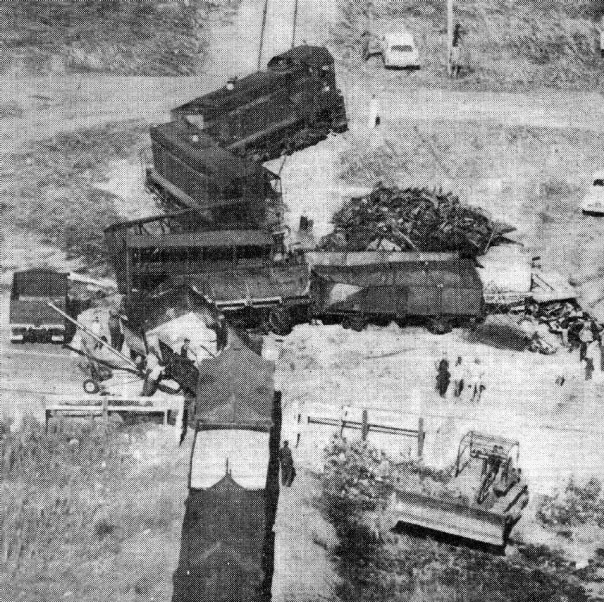
Two Y Class locomotives and six wagons were derailed when a semi-trailer travelling in the same direction as the train, collided on a level crossing east of Murrayville on 24-11-1969. The driver of the semi-trailer was burned to death. Source: "The Advertiser" newspaper cutting, author's collection
| << Back | Home | Site Map | Copyright © 2003 Bruce McLean, All Rights Reserved |